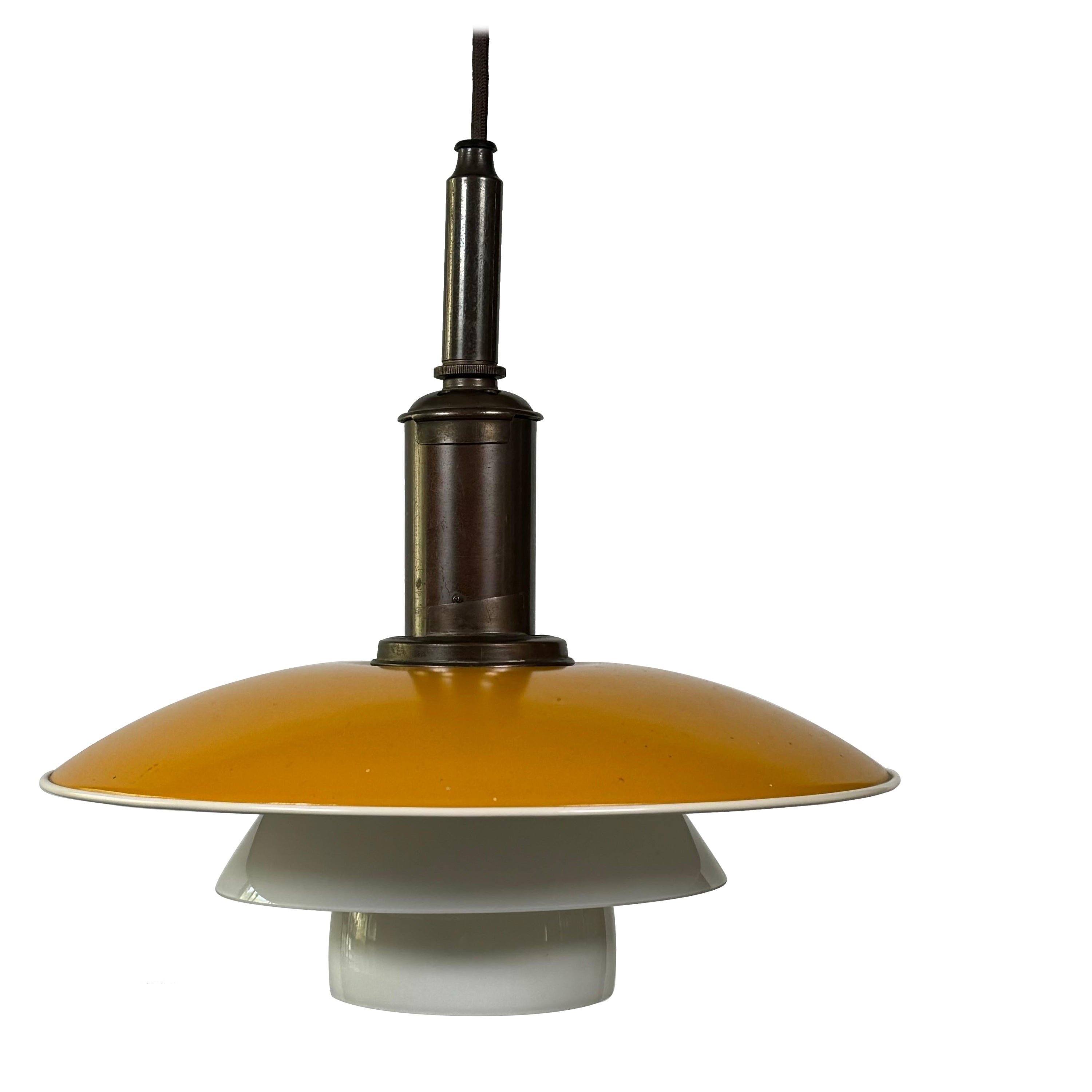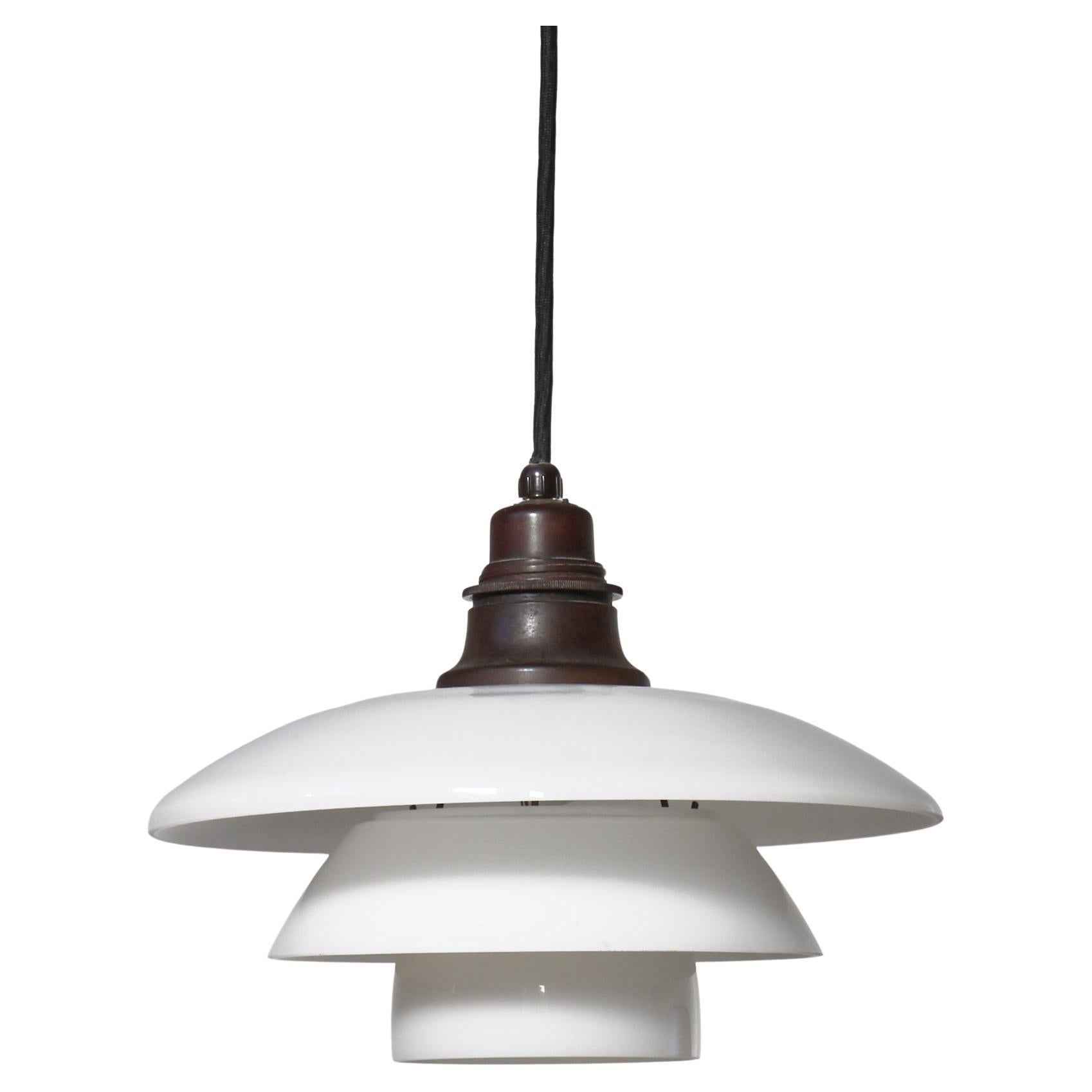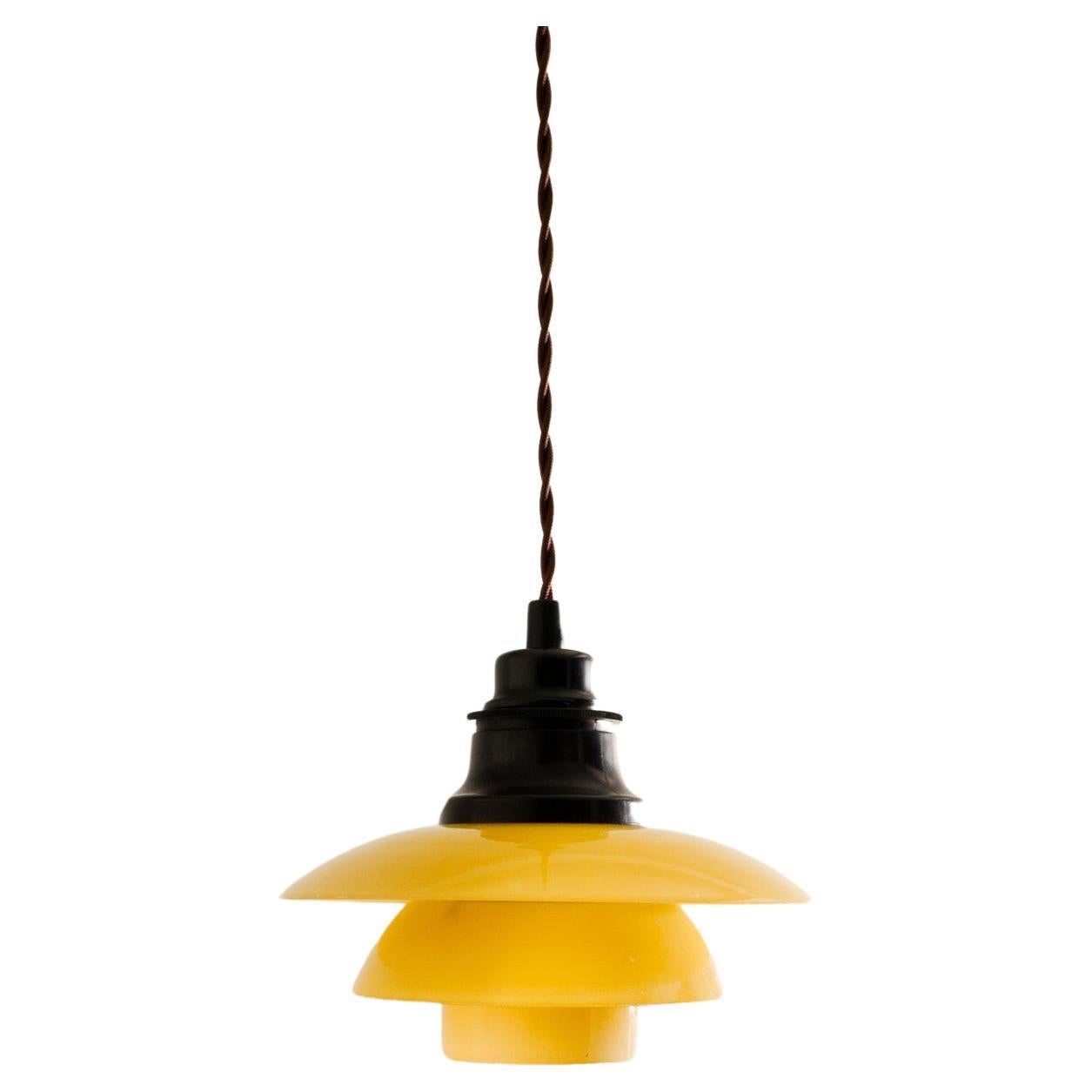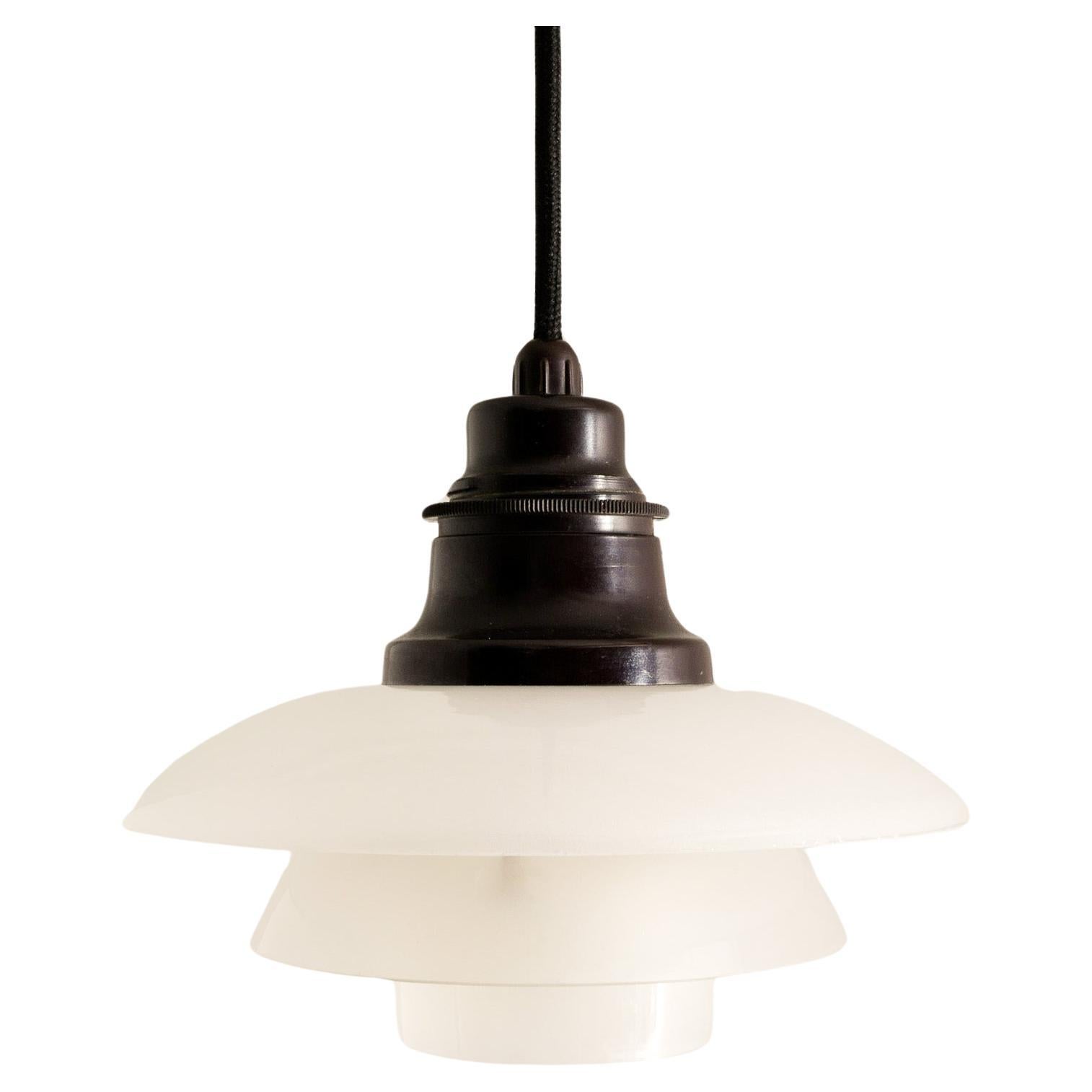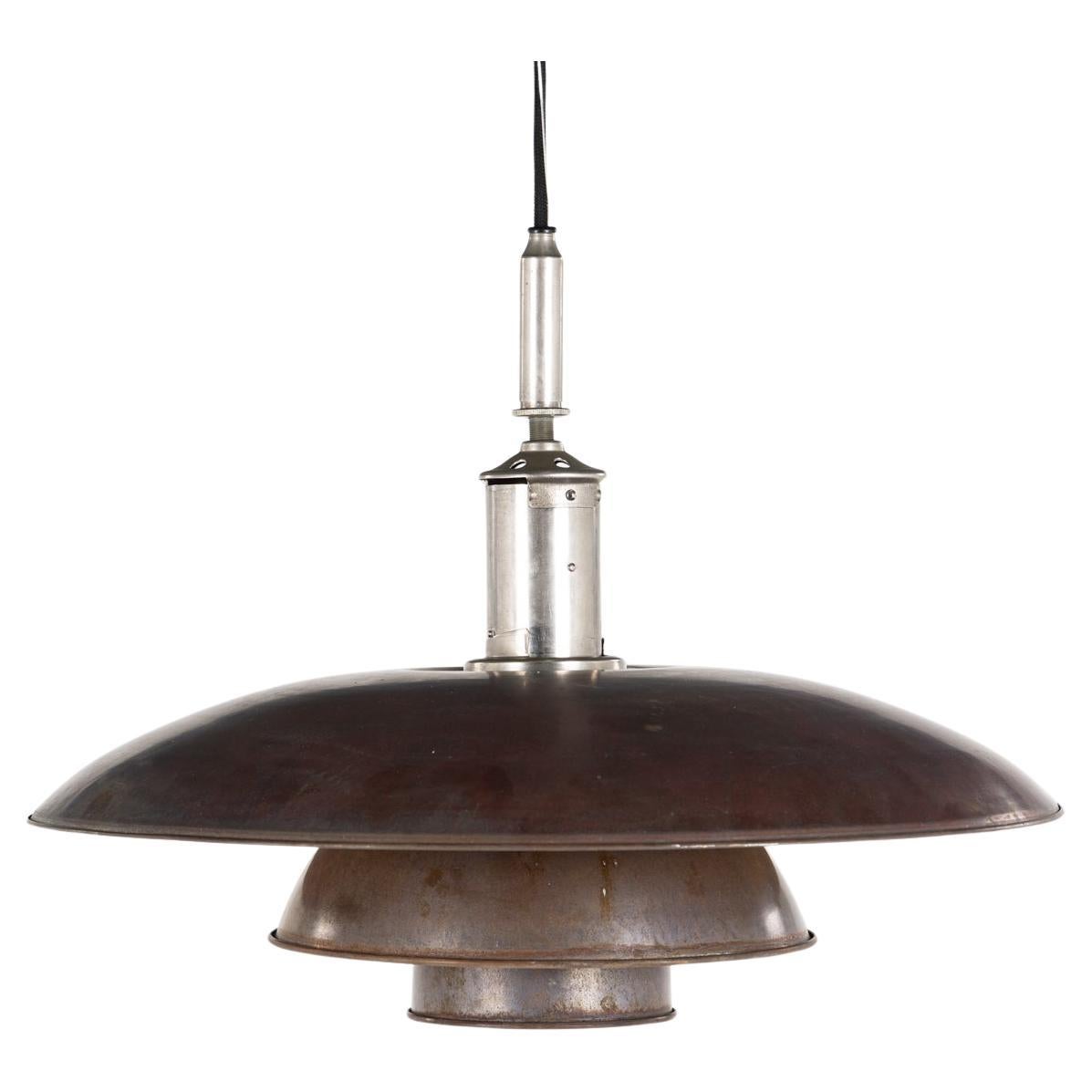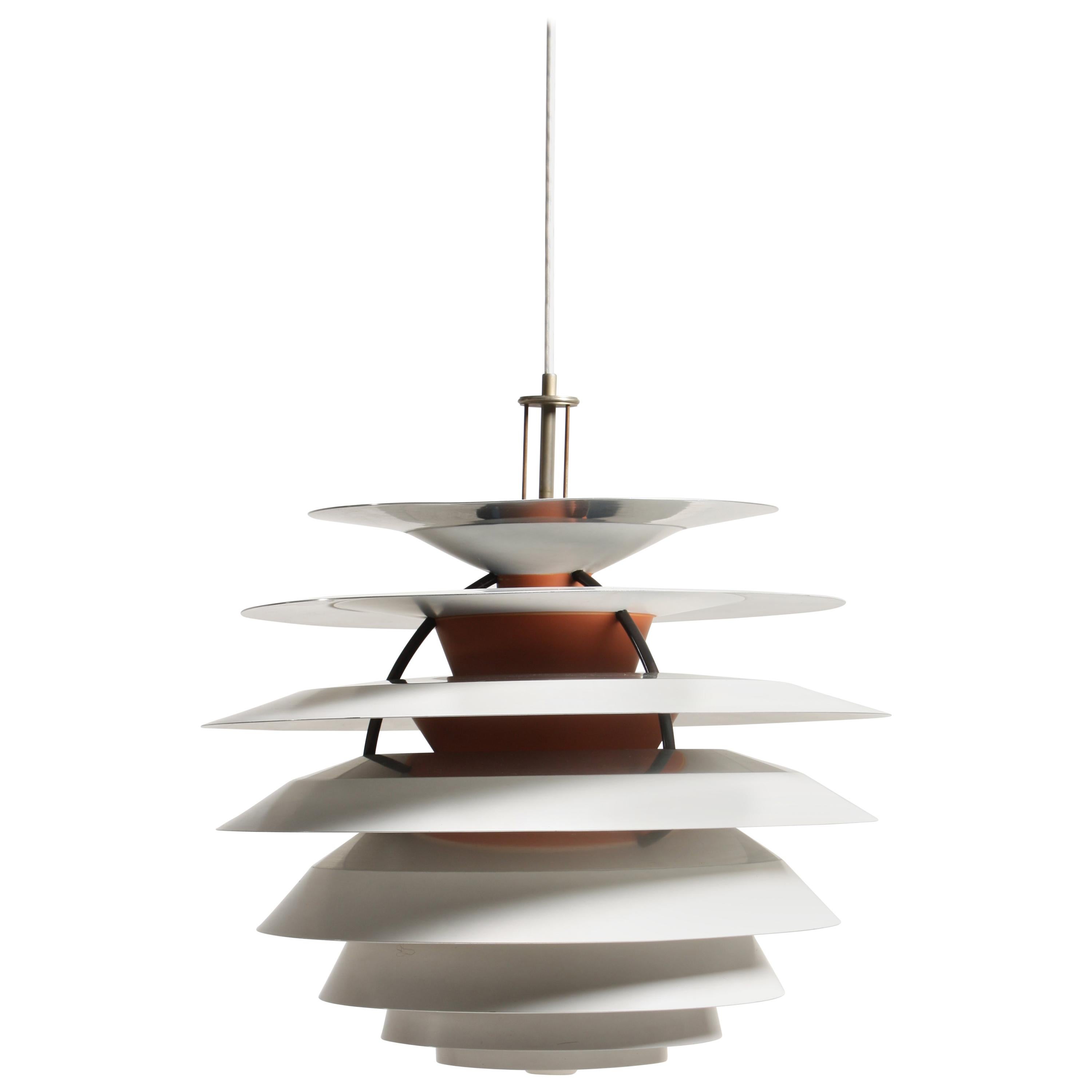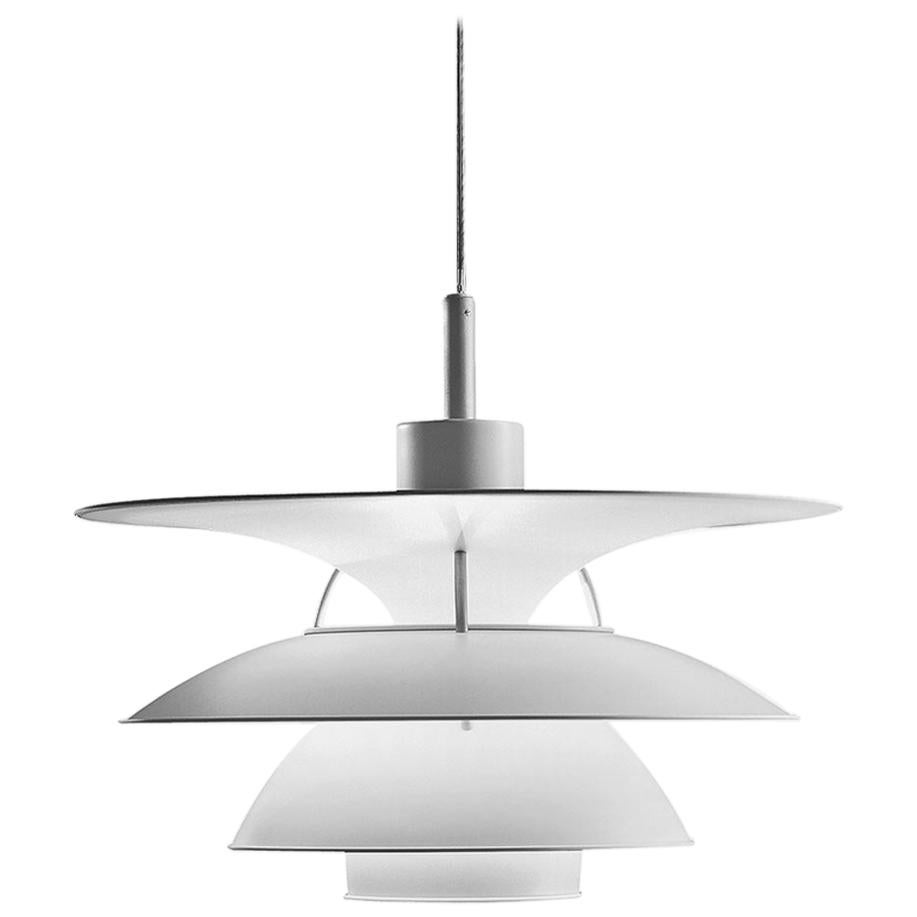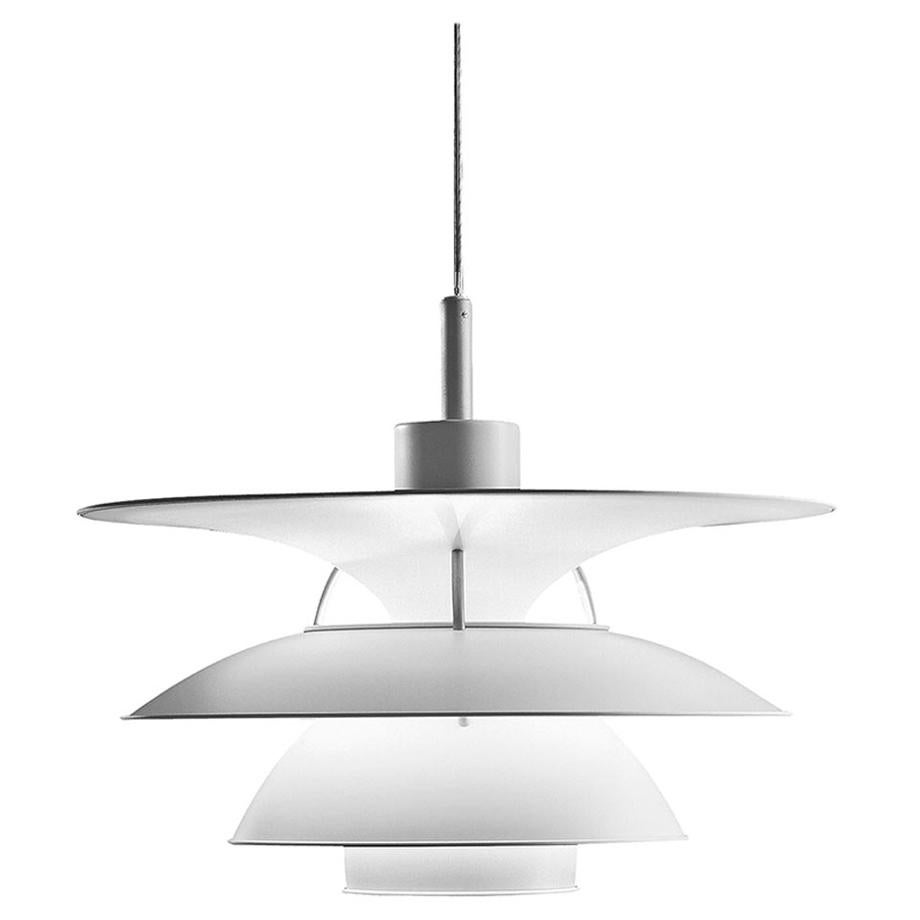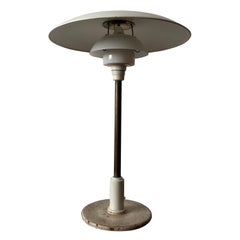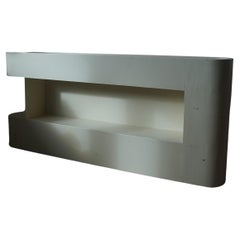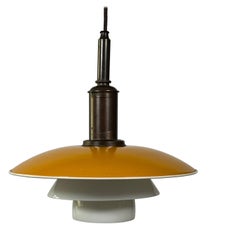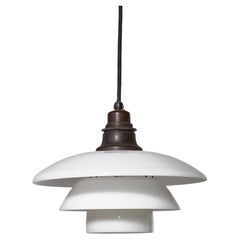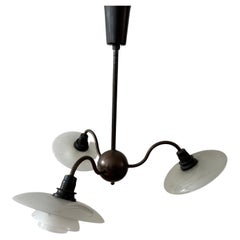
Poul Henningsen Kuglekrone, 1930s
View Similar Items
Poul Henningsen Kuglekrone, 1930s
About the Item
- Creator:Louis Poulsen (Manufacturer),Poul Henningsen (Designer)
- Dimensions:Height: 27.56 in (70 cm)Diameter: 23.63 in (60 cm)
- Power Source:Hardwired
- Voltage:220-240v
- Lampshade:Included
- Style:Scandinavian Modern (Of the Period)
- Materials and Techniques:
- Place of Origin:
- Period:
- Date of Manufacture:1930’s
- Condition:Wear consistent with age and use.
- Seller Location:Valby, DK
- Reference Number:1stDibs: LU6559234470082
Poul Henningsen
The name Poul Henningsen is synonymous with the best and most innovative modern Scandinavian lamps and other lighting. The Danish designer created a signature vocabulary of fixtures with tiered and layered shades in sculptural arrangements that are at once naturalistic and geometric.
Henningsen grew up in a town on the outskirts of Copenhagen and studied architecture at the Technical University of Denmark. He would become a noted art critic, journalist and screenwriter, but his first love was lighting design.
Henningsen’s childhood home was illuminated by oil lamps. When his family switched to electrified lighting, he was alarmed and repelled by the harsh glare cast by an incandescent bulb, and in his late teens he began conducting quasi-scientific experiments to measure which materials and methods best diffused or reflected light to give it a warm brightness. His work came to the attention of the lighting-fixtures firm Louis Poulsen, which sponsored the development of a prototype lamp. The design won a gold medal at the 1925 Paris Expositions Internationales des Arts Decóratifs et Industriels Modernes — from which the term Art Deco derives. The lamp, whose three-part shade is said to be inspired by the arrangement of a dinner plate atop a soup bowl atop a teacup, became the basis for Henningsen’s most successful design, the PH 4/3 desk lamp.
All told, Henningsen would design some 100 lighting fixtures in his career. Some of his most notable creations are hanging lamps, which include the Septima (1929), a pendant composed of seven graduated frosted-glass layers; the Spiral (1942), made of a single ribbon of enameled aluminum; and the Artichoke lamp (1958), whose 70 glass or metal fins in a staggered and graduated arrangement on a central steel frame resemble those of its namesake. The last is likely Henningsen’s masterwork and an icon of mid-20th-century design. Like all Henningsen lighting designs, it is striking, sculptural and — thanks to his insistence on the primacy of the quality of the light cast — superbly functional.
Find a collection of authentic Poul Henningsen table lamps, floor lamps and other lighting on 1stDibs.
Louis Poulsen
Louis Poulsen is world-renowned as an innovator in modern Danish lighting, but this wasn’t the goal from the start. Founded in 1874 by Ludvig R. Poulsen as a wine importer, the business went through several incarnations before its first pendant lights came to fruition. Through its designs, the company helped establish the foundations of good lighting — function, comfort and ambience — that are now standard in modern furniture design.
In 1924, Danish architect Poul Henningsen partnered with Louis Poulsen & Co., then an electrical supply company, to create what’s now known as the Paris lamp. This design, which incorporated three layers of curved metal disks, created ambience with its indirect light instead of glare. Shown at the 1925 Exposition Internationale des Arts Décoratifs et Industriels Modernes in Paris — the exhibition that brought Art Deco design to worldwide attention — the Paris lamp was awarded a gold medal. This led to Poulsen and Henningsen working together on several lighting pieces, including the popular PH pendant light with its concentric shades for the Forum Building in Copenhagen. These high-profile projects helped make Louis Poulsen a go-to purveyor of innovative lighting design.
One of the company’s most well-known lamps is Henningsen’s PH Artichoke lamp (1958), with its 72 copper leaves artfully placed to conceal the light bulb, prevent glare and promote a warm, alluring glow in any room. Another is the steel and die-cast zinc AJ lamp (1960), which Arne Jacobsen designed with an adjustable angled shade for his commission for the SAS Royal Hotel in Copenhagen. The company has also worked with notables such as Verner Panton and Alfred Homann as well as, more recently, Louise Campbell and Oki Sato.
In 2010, the company was awarded the American Institute of Architects’ Honors in Collaborative Achievement Award; it was the first lighting manufacturer to receive this honor. In 2018, the company was acquired by an investment subsidiary of Investindustrial VI L.P. Still headquartered in Denmark, the brand continues to produce its high-end lighting for both indoor and outdoor use, manufacturing both classic icons as well as new designs. “We design to shape light,” states Louis Poulsen. In doing so, they have also shaped culture.
Find a range of new and vintage Louis Poulsen floor lamps, table lamps and other lighting and furniture on 1stDibs.
- Poul Henningsen Table Lamp model 3/2, 5 manufactured by Louis Poulsen 1940’sBy Louis Poulsen, Poul HenningsenLocated in Valby, 84Poul Henningsen Table Lamp model 3/2,5 manufactured by Louis Poulsen 1940’s, the lamps frame has a white Bakelite bulb socket and switch housing and a darke...Category
Vintage 1940s Danish Scandinavian Modern Table Lamps
MaterialsMetal, Brass, Zinc
- Functionalist Room Divider Denmark, 1930sLocated in Valby, 84Rare Functionalist Room Divider and Jardinieres made in Denmark in the 1930s in lacquered plywood. This piece is the perfect room divider since it lacquered on both sides and therefore can be free standing, but it can also be used as a sideboard or a jardinieres since it has the room in the top which is perfect for your favourite plants. This piece is a great example of Danish Functionalism and has similarities to pieces by architects like Vilhelm Lauritzen, Frits Schlegel, Arne Jacobsen and Kaj Gottlob who all were pioneers in danish modernism and have had a big influence on the coming generations of architects. This room divider comes from a danish house...Category
Vintage 1930s Danish Scandinavian Modern Sideboards
MaterialsPlywood
- Evan Jensen Bronze Dish, Denmark, 1930sBy Evan JensenLocated in Valby, 84Bronze Art deco dish/charger by Danish artist Evan Jensen from the 1930's in a beautiful original condition, the dish is signed Evan Jensen Copenhagen Bronze and has model number 320. The dish has a very decorative image of a deer on the front. The dish is the perfect dish to have standing as a piece of art but can also be used as a bowl to store stuff like fruit or nuts or whatever else you could think of. Art Deco, short for the French Arts Décoratifs, and sometimes just called Deco, is a style of visual arts, architecture, and product design, that first appeared in France in the 1910s (just before World War I), and flourished in the United States and Europe during the 1920s and 1930s. Through styling and design of the exterior and interior of anything from large structures to small objects, including how people look (clothing, fashion and jewelry), Art Deco has influenced bridges, buildings (from skyscrapers to cinemas), ships, ocean liners, trains, cars, trucks, buses, furniture, and everyday objects like radios and vacuum cleaners. It got its name after the 1925 Exposition internationale des arts décoratifs et industriels modernes (International Exhibition of Modern Decorative and Industrial Arts) held in Paris. Art Deco combined modern styles with fine craftsmanship and rich materials. During its heyday, it represented luxury, glamour, exuberance, and faith in social and technological progress. From its outset, Art Deco was influenced by the bold geometric forms of Cubism and the Vienna Secession; the bright colours of Fauvism and of the Ballets Russes; the updated craftsmanship of the furniture of the eras of Louis XVI and Louis Philippe I; and the exoticized styles of China, Japan, India, Persia, ancient Egypt and Maya art. It featured rare and expensive materials, such as ebony and ivory, and exquisite craftsmanship. The Empire State Building, Chrysler Building, and other skyscrapers of New York City built during the 1920s and 1930s are monuments to the style. In the 1930s, during the Great Depression, Art Deco became more subdued. New materials arrived, including chrome plating, stainless steel and plastic. A sleeker form of the style, called Streamline Moderne, appeared in the 1930s, featuring curving forms and smooth, polished surfaces. Art Deco is one of the first truly international styles, but its dominance ended with the beginning of World War II and the rise of the strictly functional and unadorned styles of modern architecture and the International Style of architecture that followed. This dish is the perfect detail for any interior from the modern Wabi Sabi style...Category
Vintage 1930s Danish Scandinavian Modern Decorative Dishes and Vide-Poche
MaterialsBronze
- Evan Jensen Bronze Vase, Denmark, 1930sBy Evan JensenLocated in Valby, 84Rare bronze vase attributed Evan Jensen made in Denmark in the 1930s. The vase is made by a unknown danish caster called Antika but is a typical Evan Jensen shaped vase and has typical Evan Jensen detail. The vase is in good condition with a beautiful original patina. Art Deco, short for the French Arts Décoratifs, and sometimes just called Deco, is a style of visual arts, architecture, and product design, that first appeared in France in the 1910s (just before World War I), and flourished in the United States and Europe during the 1920s and 1930s. Through styling and design of the exterior and interior of anything from large structures to small objects, including how people look (clothing, fashion and jewelry), Art Deco has influenced bridges, buildings (from skyscrapers to cinemas), ships, ocean liners, trains, cars, trucks, buses, furniture, and everyday objects like radios and vacuum cleaners. It got its name after the 1925 Exposition internationale des arts décoratifs et industriels modernes (International Exhibition of Modern Decorative and Industrial Arts) held in Paris. Art Deco combined modern styles with fine craftsmanship and rich materials. During its heyday, it represented luxury, glamour, exuberance, and faith in social and technological progress. From its outset, Art Deco was influenced by the bold geometric forms of Cubism and the Vienna Secession; the bright colours of Fauvism and of the Ballets Russes; the updated craftsmanship of the furniture of the eras of Louis XVI and Louis Philippe I; and the exoticized styles of China, Japan, India, Persia, ancient Egypt and Maya art. It featured rare and expensive materials, such as ebony and ivory, and exquisite craftsmanship. The Empire State Building, Chrysler Building, and other skyscrapers of New York City built during the 1920s and 1930s are monuments to the style. In the 1930s, during the Great Depression, Art Deco became more subdued. New materials arrived, including chrome plating, stainless steel and plastic. A sleeker form of the style, called Streamline Moderne, appeared in the 1930s, featuring curving forms and smooth, polished surfaces. Art Deco is one of the first truly international styles, but its dominance ended with the beginning of World War II and the rise of the strictly functional and unadorned styles of modern architecture and the International Style of architecture that followed. This vase is the perfect detail for any interior from the modern Wabi Sabi style...Category
Vintage 1920s Danish Scandinavian Modern Vases
MaterialsBronze
- Evan Jensen Bronze Vase, Denmark, 1930sBy Evan JensenLocated in Valby, 84Evan Jensen bronze art deco vase made by Danish artist Evan Jensen in the 1930s. The vase is in a beautiful original condition and is signed Evan Jensen København Bronze and has model number 155A. The vase is a beautiful decorative element to any interior and the structure of the vase is fantastic with lots of details which will give you endless hours of enjoyment looking at. Art Deco, short for the French Arts Décoratifs, and sometimes just called Deco, is a style of visual arts, architecture, and product design, that first appeared in France in the 1910s (just before World War I), and flourished in the United States and Europe during the 1920s and 1930s. Through styling and design of the exterior and interior of anything from large structures to small objects, including how people look (clothing, fashion and jewelry), Art Deco has influenced bridges, buildings (from skyscrapers to cinemas), ships...Category
Vintage 1930s Danish Scandinavian Modern Vases
MaterialsBronze
- Pine Book Case by a Cabinetmaker, 1930sBy Axel Einar HjorthLocated in Valby, 84Rare patinaed book shelf by an unknown Swedish cabinetmaker in solid acid stained pine wood. The shelf consists of two shelf’s and very art deco inspired feet and raised edges on th...Category
Vintage 1930s Swedish Scandinavian Modern Bookcases
MaterialsPine
- 1930s Poul Henningsen PH Model 3/2 Pendant Lamp for Louis PoulsenBy Louis Poulsen, Poul HenningsenLocated in Oakland, CAEarly 1930s Poul Henningsen 3/2 pendant lamp for Louis Poulsen & Co. of Denmark. Copper and glass construction, the top shade in a lacquered mustard colored copper shade and the bott...Category
Vintage 1930s Danish Scandinavian Modern Chandeliers and Pendants
MaterialsMetal
- Louis Poulsen "PH-lamp" 3/3 Pendant by Poul Henningsen, Patented, Denmark, 1930sBy Louis Poulsen, Poul HenningsenLocated in Odense, DKEarly original "PH-lamp" pendant made in the 1930s at Louis Poulsen, Copenhagen. This is the "3/3" sized pendant with original opaline shades and bakelite socket house as invented by...Category
Vintage 1930s Danish Scandinavian Modern Chandeliers and Pendants
MaterialsGlass, Bakelite
- Early Yellow Poul Henningsen "PH 2/2" Mid Century Pendant by Louis Poulsen 1930sBy Louis Poulsen, Poul HenningsenLocated in Stockholm, SEVery rare small mid century "PH 2/2" ceiling pendant in patinated brass, bakelite and original yellow opaline glass shades by Poul Henningsen produced by Louis Poulsen Denmark, 1930s...Category
Vintage 1930s Danish Scandinavian Modern Chandeliers and Pendants
MaterialsBrass
- Early White Poul Henningsen "PH 2/2" Mid Century Pendant by Louis Poulsen 1930sBy Louis Poulsen, Poul HenningsenLocated in Stockholm, SEVery rare small mid century "PH 2/2" ceiling pendant in patinated brass, bakelite and original white opaline glass shades by Poul Henningsen produced by Louis Poulsen Denmark, 1930s....Category
Vintage 1930s Danish Scandinavian Modern Chandeliers and Pendants
MaterialsBrass
- Poul Henningsen PH 3/2 AkademikroneBy Louis Poulsen, Poul HenningsenLocated in Vienna, ATThe three bright spots are designed on the principle of a reflective three-shade system, which directs the majority of the light downwards. The screens are made of three-layer blown ...Category
20th Century Danish Scandinavian Modern Chandeliers and Pendants
MaterialsChrome, Steel
- Early Poul Henningsen Copper Table Lamp, 1930sBy Louis Poulsen, Poul HenningsenLocated in Copenhagen, DKPoul Henningsen & Louis Poulsen, Mid-century Modern design This is the iconic Poul Henningsen (PH 4/3) table lamp with original copper shades. Stand, switch and socket house of bro...Category
Mid-20th Century Danish Scandinavian Modern Table Lamps
MaterialsCopper
